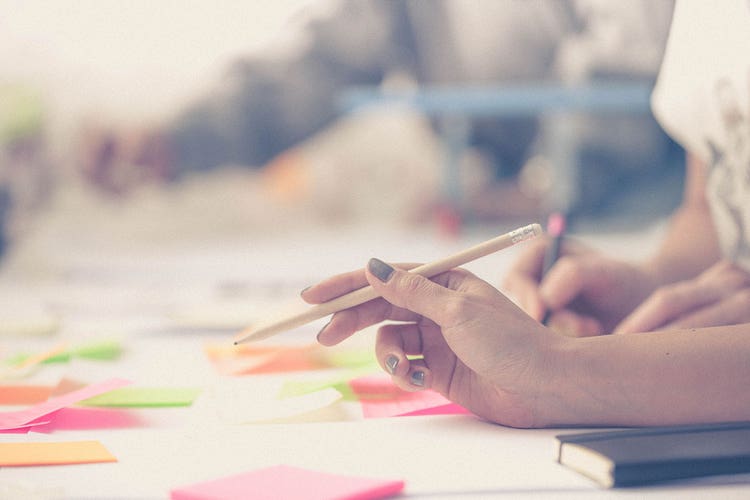Design a Better Anything

24 ways to design your thinking and increase your creative confidence.
Design is ubiquitous. It’s everywhere. We experience it in the cars we drive, the phones we use, the way we consume our coffee and the experiences we have at our jobs. Bad design leads to never-ending frustration, and good design either takes our breath away or is taken completely for granted.
We are all designers. We create consciously and unconsciously in every area of our lives. This begs the question: What is it that generates a flawless user experience? What is the process to create something great, and what can we learn from it to improve the way we create in our own lives?
To consider these questions, we went back to school to study with an inspired group of creators and masters of design thinking at IDEO U. IDEO U is an online school where anyone can unlock their creative potential through design thinking and collaboration. IDEO U courses are available for individuals, teams and organizations, and they are an excellent pathway for understanding the use and application of design thinking to solve anything in your life more creatively.
At its simplest explanation, design thinking is a methodology or process used by world-class thinkers and designers to solve a variety of complex and intricate problems—and thereby discover desirable solutions to create products, programs and services. There are many world-renowned applications of design thinking and even more famous products and services that have resulted in your favorite gadgets or experiences, including the phone or device you are likely using to read this article.
What’s amazing is that the process is unbiased and works equally well when applied to everyday problems and challenges. Because design thinking draws on logic, imagination, intuition and systemic reasoning to explore possibilities of what could be—and to create desired outcomes that benefit the end user—it has incredible application to support anything you wish to create, whether that be a workout, a card for someone you love or a better day.
If you would like to give your own insights a design-thinking boost, jump into IDEO U’s introductory course Hello Design Thinking, which is designed to increase your creative confidence in 90 minutes!
In the meantime, here are some ideas to put it into play in your world. May these 24 design tips slow down time and guide you to co-create with joy.
1. Believe in your creative capacity
Your genius is your birthright, but it’s up to you to cheer it on. As David Kelley, one of the co-founders of IDEO and a creative force behind many of today’s most famous products, says, “Belief in your creative capacity lies at the heart of innovation.” As young children, we believe in our invincible ability to solve problems with vigor and enthusiasm. Return to that spirit.
2. Raise your ambitions
Perhaps the task at hand is simple and you can do it with one eye closed. What if you leveled it up and challenged yourself to create a masterpiece? What if it made the day so much better for you and for others? As Tim Brown, CEO of IDEO, says, “Our role is not just to solve the problems of today but to solve the problems coming over the horizon.” Maybe it will take a little more time to solve, but finishing quickly is not all that satisfying as we have all experienced. Imagine what you could create and how alive you would feel.
3. Work your idea muscle
An idea is not meant to stay in your head. Ideation is the process of generating ideas, yes. It is also the process of developing and testing ideas—not just listing them. An idea needs to be put into play, stretched out, fully considered, vetted, imagined and realized as a prototype before it can be evaluated fully for its merit. What is most valuable about the process is not always the idea itself but the insights gained along the way and the process and collaboration the team creates as it considers the possibilities.
4. Take a human focus

Design thinking is a process that is helpful for creative problem-solving or creating anything that you can imagine, but it doesn’t start with a focus on the “what.” The best solution or outcome generates with a deep focus on the people or person and their needs. Human beings are the center of the story, and we are reminded in and through the process to put people first. Consider and observe objectively: What do they need, want, desire? What are their unique challenges, frustrations, pleasures? What will work for them and what will not? This is referred to as human-centered design, and anyone can use it to tap into their creative potential and grow in-demand skills to be more effective with their relationships, work and personal pursuits.
5. Grant your own permission
First, you have to start and you don’t have to be perfect out of the gate, or anytime. A remarkable design doesn’t require perfection along the way. The perfection culminates as a result of a messy, windy pathway through a creative process. It is typically not a straight line from start to finish. IDEO offers good advice. “Give yourself permission to step outside your comfort zone and think differently,” Brown says. “For some, this can feel strange or messy. I always encourage people to just dive in and stick to it.” This applies whether you are designing a beautiful relationship with your spouse, a new onboarding process for your customer or a new workout to achieve your goals. Dive in and stick to it.
6. Dig for insight
A successful anything is built with three key ingredients: insight, observation and empathy. And, if allowed, a fourth ingredient: Add a pinch of playfulness. Of them all, insight is gold. Insights allow us to upgrade the now, to refine or rethink our existing assumptions. Once you have gleaned an understanding and struck an “aha” moment of insight, you have the means to create something new.
7. Be observant
One would think observation is an easy skill. We are observing all the time—people, our breath, laws, cultures and so on. But true observation is a deep practice. Anthropologists treat it as a sacred art form and core methodology that leads to the most profound of insight. When observing others, you have to also observe yourself in the process. It’s nearly impossible to unpack one’s own prejudice, and how we think impacts how we see—and also what we don’t see. In fact, when observing what people are doing and how they are behaving, it is equally important to watch what people don’t do and learn from what they don’t say.
8. Prepare for encounters of an empathetic kind
No matter what your goal, if you start with empathy, everything moves forward with more ease. Empathy is a mental habit and a way of emotional understanding. It is as our mother taught us to stand in the shoes of another and think, feel, observe and plan from there. When we truly take the time and make the space (in our minds, hearts and day) to practice empathy, not only does the outcome change for the better, but we are also transformed at the deepest level.
9. Turn the problem into a project
Language is everything. If we label something a problem, it carries with it all the preconceptions of intense experiences and expectations that we associate with big problems in our life or work. Every problem can be viewed as a design challenge. Reframe the problem or problems in the form of a question or a project with a bright adventurous future. How might we do X while achieving Y? This way of thinking opens new pathways of ideas, encourages an “I can do this” attitude and invites collaboration—all much more fun than dealing with a problem.
10. Learn to toggle your mindset
Thinking creatively requires that you disrupt your normal conditioned ways of thought. When solving problems with design thinking, it is helpful to dance between four mental states, each of which has its own experience and generates a pathway to a specific outcome. In the West, we are habituated to a linear, logical, deductive way of thinking and love to analyze and converge on a single answer. Group thinking and working with a team often leads to this type of answer. However, it is not great for creating future new possibilities. Another way of thinking is divergent thinking, which instead serves to give multiple options and new and different choices. The more ideas and choices, the better, especially if ideas compete and are creatively disruptive. Divergent thinking is more complex and may add more time at first, yet it is a critical step in the birth of any new solution to an old problem.
11. Same game, new name
It is true that we employ our thinking caps every day. But design thinking asks more of you. It is embodied thinking, which calls on you to use every ounce of your human spirit as a whole creative being, not just as an intellectual. In fact, your human experience and the strange subjects you studied in undergraduate school, like cultural anthropology, are the most liberating in that process. This interdisciplinary approach to thinking is important and brings forward the most valuable insights and breakthroughs. This doesn’t mean you have to abandon your business acumen, but digging a little deeper will serve the project well.
12. Team up

Complex problems are best solved collaboratively. Design thinking is fundamentally an exploratory process and will lead to unexpected and unimagined discoveries and inventions along the way—especially if there are great minds working in tandem to bring something new to life. There truly is so much more to do together, and the world needs the creative efforts of everyone, not just a select few. “When a team of talented, optimistic and collaborative design thinkers come together, a chemical change occurs that leads to unpredictable actions and reactions,” says Brown, describing the magic of good teamwork. Take time to bring the right people together in every area of your life.
13. Be brief
Succinct communication has its place, but even more valuable is a well-written brief. Properly framing the challenge at hand is critical to your success. In design thinking, a brief is a set of mental constraints that define the challenge and give a framework from which the “work” can begin. It sets the goals or objectives out for all to consider and gives a pathway for all involved. This is an important, often skipped, step. Instead of calling a two-hour meeting with the entire team to discuss the next project, spend two hours with a smaller squad and draft a good brief. This will give the project a proper start. A brief is not intended to constrain or conform ideas to the current reality but to literally mark the point in time and space where it all began. Begin by drafting a single short and easy-to-remember single sentence that conveys the big idea using the framework of “How Might We. …” Think big and drive to maximum impact—then articulate and capture the current constraints and context. The goal is to paint a picture that can inspire inspiration and creative solutions.
14. Breathe life into your work
We have all experienced those situations in which all decisions are controlled and there is little room for a blip of feedback, let alone a new idea or concept. This happens in families as we design our dream weddings and at work as the new initiative is brainstormed. When there is only one way or the highway and little to no collective creation or ownership, the lack of experimental process will strangle the lifeblood out of the project, and frankly, the future success of the project will be less than it could have been.
15. Release the pressure valve

High performance of any kind under pressure is an art and a skill. Design under pressure is a special condition, and it’s too important to leave only to those officially labeled “designers.” Everyone can benefit by bringing their most inspired work or idea forward into the world. It will get intense along the way, but the pressure is good for all of us—and even better if along the way we manage the experience and set realistic (yet aspirational) expectations. Release the pressure to solve the challenge out of the gate and focus instead on learning the process, practicing new skills and collaborating with others—including commingling ideas.
16. Dot your i’s
Human-centered design is achieved by continuously filtering through three spaces of innovation: inspiration, ideation and implementation. When you keep people at the center of the work or a conversation, you are better positioned to evolve through challenges, even when complex. This is true in everything we do and even adds value in our relationships. Inspiration moves us. It is the spark that motivates our search for a new solution and comes out of our care for others or a deeply held desire to bring forward an idea or dream. Ideation is the juice—it is where we allow our human resources to flow freely and imagine all varieties of possibilities to come forward with equal opportunity. Implementation is critical. It is the path that brings the future into our present reality. Without implementation, neither inspiration nor ideation have their chance to dance in the daylight. Be sure that as you move through the various domains of your life, you are giving inspiration, ideation and implementation ample space to breathe.
17. Love your tools
Innovation requires method and madness—an open mindset. Putting them together is key. Over the last few decades, design thinking has developed a vast resource of tools to wake up and guide the creative process. As in any creative initiative, tools are a means to an end and are best used with an open mind and not as a prescriptive step-by-step tutorial. Instead, learn to love the tools of your trade, to explore a variety of fresh approaches and even kick-start your own insights. For further inspiration, IDEO created a deck of cards divided into four categories: learn, look, ask and try. They recommend using these whenever you need to trigger a new perspective, inspire a team, or manifest a breakthrough when stuck or if the energy feels stale.
18. Invest in the interview
There are lots of ways to gather information, especially given the abundance of data everywhere. Still, the best sharing of ideas comes in real time between two humans in conversation. If you want to understand something better, then interview someone involved at the root of the experience. A direct conversation remains the best way to discern and understand the hopes, desires and aspirations. Interviews really are the crux of the inspiration phase. Human-centered design is about getting to the people you’re designing for and hearing from them in their own words. Interviews can be a bit daunting, but by following these steps below, you’ll unlock all kinds of insights and understanding that you’ll never get sitting behind your desk. Whenever possible, conduct your interviews in the interviewee’s space. You can learn so much about a person’s mindset, behavior and lifestyle by talking with them where they live or work. When you interview, come prepared and respectful of the time someone is giving you, and begin by asking general lifestyle questions, especially asking more “why” questions than “what” questions. Slowly circle in on the process or subject at hand. Record quotes. Don’t analyze or edit while in conversation—just take it in and pay attention to the energy, the body language and also what is not said. All of it guides you forward in your quest for insight.
19. Design for experience
The modern world takes care of almost everything we need. As a result of this affluence and abundance, humans now seek meaningful, satisfying experiences that are memorable and that stand out from the glut of information and industrial products that bombard us at every turn. Design thinking is inherently experiential, and the process supports the development of never-before-created products or experiences that engage our senses and emotions and draw us to interact and participate fully. The sign of a good experience design is the interest to linger just a little bit longer, to explore just a bit further and a desire to understand just a bit more—especially when the service or product is perceived as personalized for the consumer. This applies to our lives and our workouts, too. The days are simply not fun when you’re stuffed to the rafters with busyness and endless activities. Lose the hustle, make room for hospitality and build in a few of what designers call “exhale moments.” These are moments that take your breath away, when you can let down all your protective boundaries. Take actions to design a day you want to actually talk about (and even repeat!) tomorrow.
20. Plan it out

While every project is unique and with the mantra that there really isn’t one best way to move through the design process, it is very helpful to draft a plan. Logistics can sideline a plan, and while the path will change as things progress, a plan keeps the timeline, budget constraints and deadlines in plain view. Understanding what you have to work with, who is available to support, and the physical space, tools and resources at your fingertips is fuel for your fire. Creativity abounds when constraints are put in place. Calendar your timeline and set out markers as checkpoints for progress. List your key questions, especially the open-ended concepts that you don’t currently know. Enthusiastically accept this plan as a launch pad intended to reveal an even better path along the way. The plan also provides a space to record everything you do and opt to not do—and is key to linking inspiration and ideation to implementation. Too many good ideas don’t get a fighting chance simply because they didn’t have a plan to back them up.
21. Plan to fail, and fast
There really is no use for the concept of failure except to understand that yes, it is going to happen, and yes, you are on schedule. If you fail trying, think of it as failure and another start. Think of it as data on the journey in your experiment. When you should be concerned is if you are not failing at all. If that is the case, take a good hard look around and decide whether you are playing a game that is too small. Big challenges require risk-taking, mind-blowing attempts that will indeed derail you completely. A worthy mindset when that happens is to get curious and find out how to better listen, think, build and refine the way forward to better serve as planned. Failure is an inherent, integral and inevitable part of the process because we’ll just never get it right on our first try.
22. Go pro
Sometimes we can handle things on our own, and sometimes we need professional help. Knowing when to say “help!” is key to design thinking. Of course, almost everything is figureoutable. (Thank you, Marie Forleo, for that perfect word!) But time is valuable, and having expert insight can be exactly the key breakthrough needed to move the project forward and keep you from spinning into despair. The talented minds that you surround yourself with will speed up your process of innovation and expand your personal way of thinking. Having support helps you open your eyes, to be present, to notice the important things instead of being in a panic about what you don’t know how to do.
23. Surround yourself with open-minded leadership
The world needs creative leaders. The way we have always done things is a battle cry used too often across the world’s schools, hospitals, corporations and in the government organizations that are intended to serve. Looking around at the state of the world’s affairs—the old way of thinking is not doing us any favors or moving us forward on the biggest issues facing humanity. A new and disruptive way of thinking, understanding, collaborating and creating solutions is critical and necessary. To think differently, surround yourself with minds that are committed to doing the same.
24. Tell the tale
Our lives are because of those who came before us. Their physical story lives through our DNA, and we evolve our current design because they were brave and solved the problems of their time. We do the same for our future, and even more critically, we continue to design the human story along the way. As your project, career, fitness experience, love life, relationship or general life progresses, record it. Write down the story with all its gory details so you can share it with others now and along the way. This is what Tim Brown calls the fourth dimension. Storytelling is designing with time—we design with verbs, not nouns. Design at its best is how we live our lives. Design something that makes you come alive fully. Go, gather, generate, make and share. Make today the day that you craft a human story—your story—that inspires others toward action.
Photo credits: czamfir, Vladimir Badaev, Syda Productions, SFIO CRACHO, Tijana, Adobe Stock